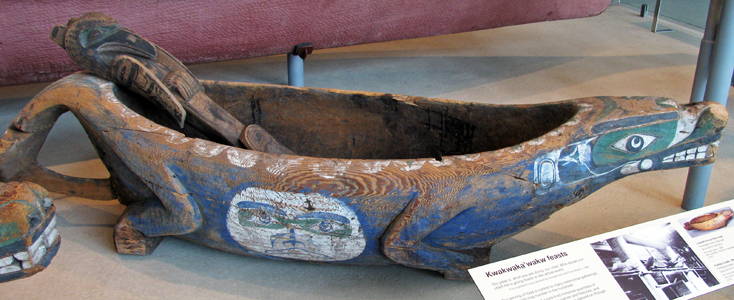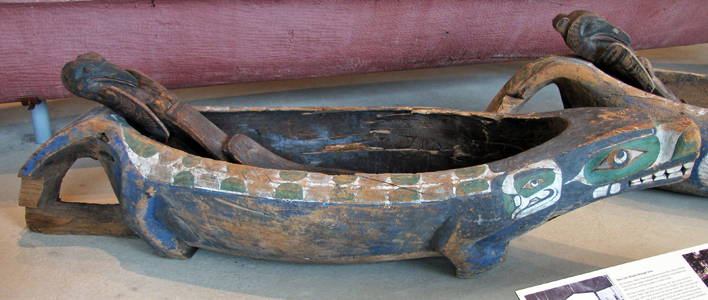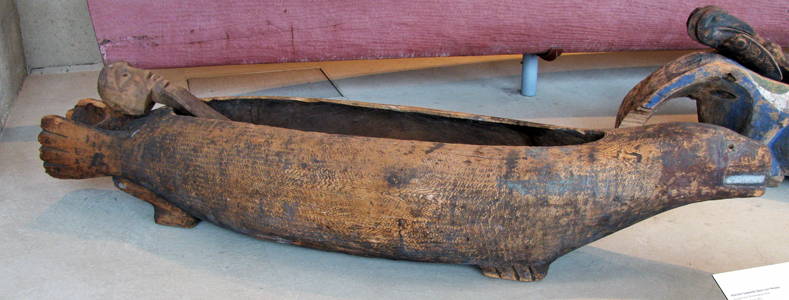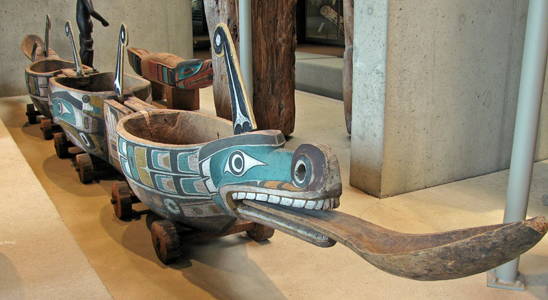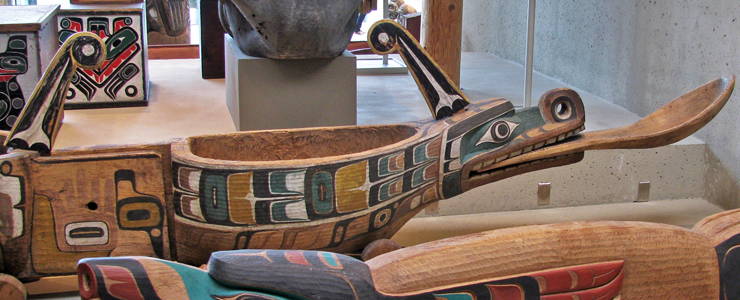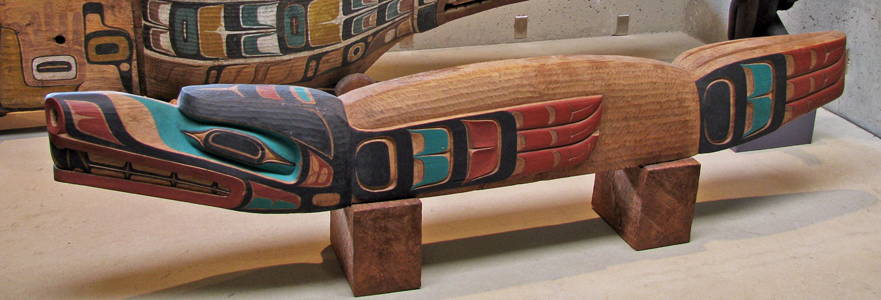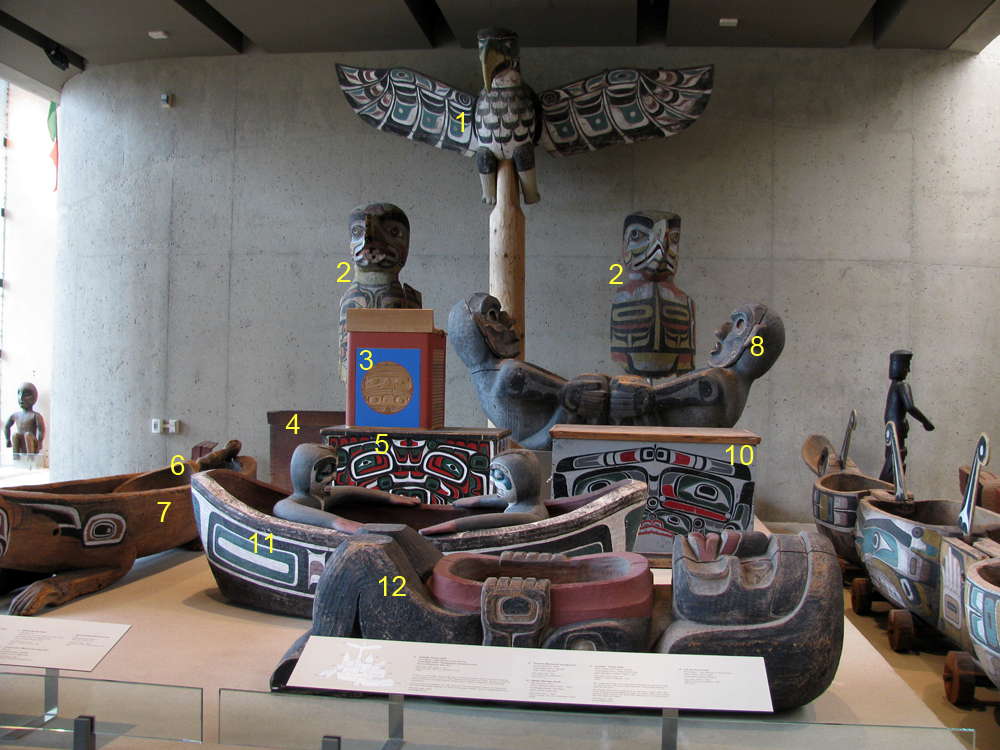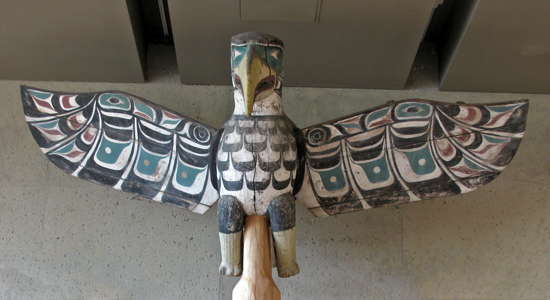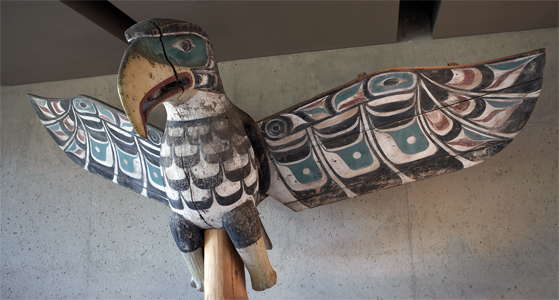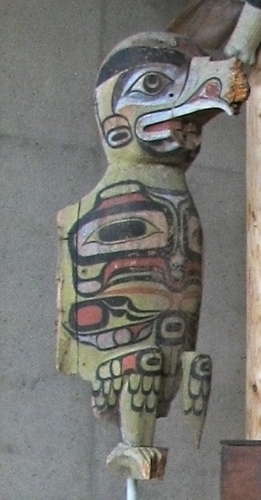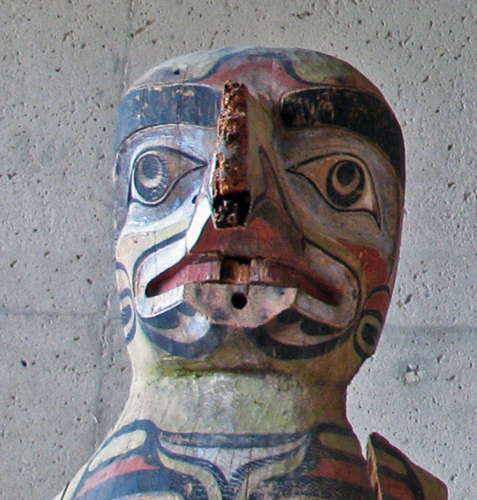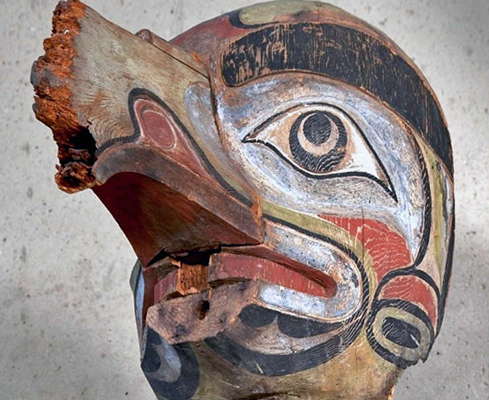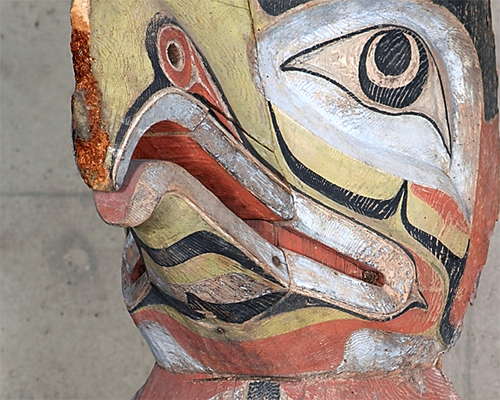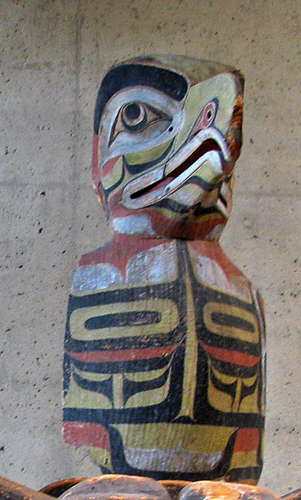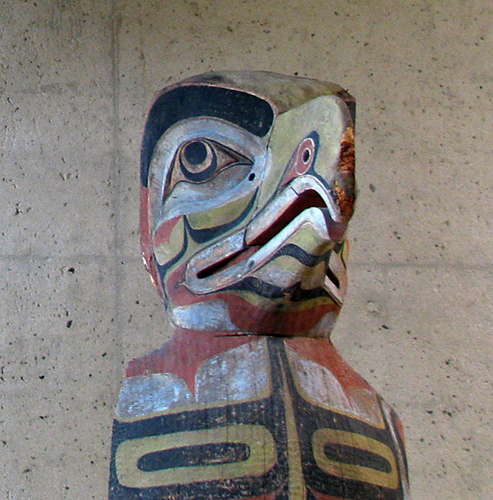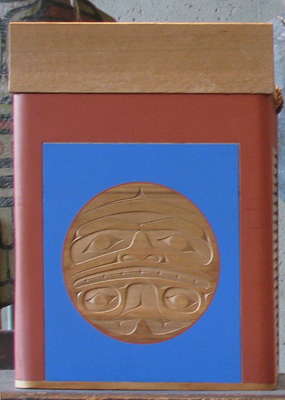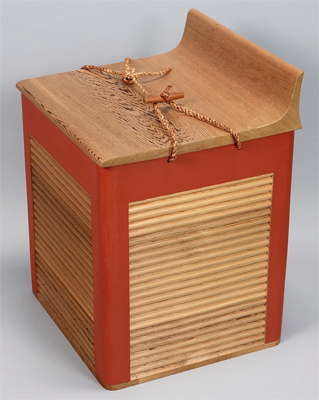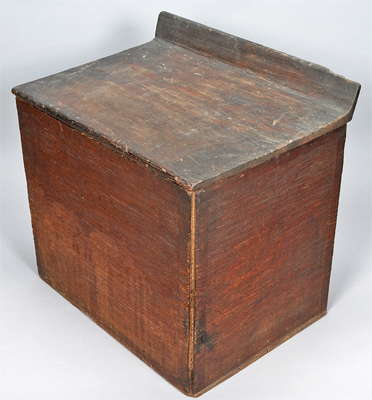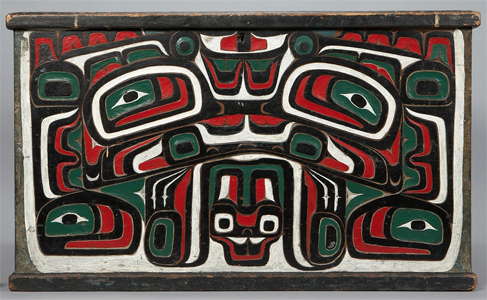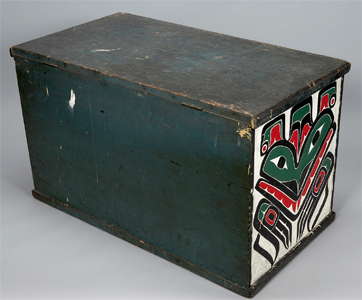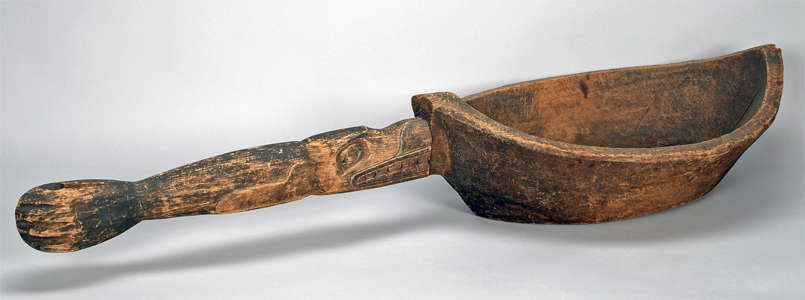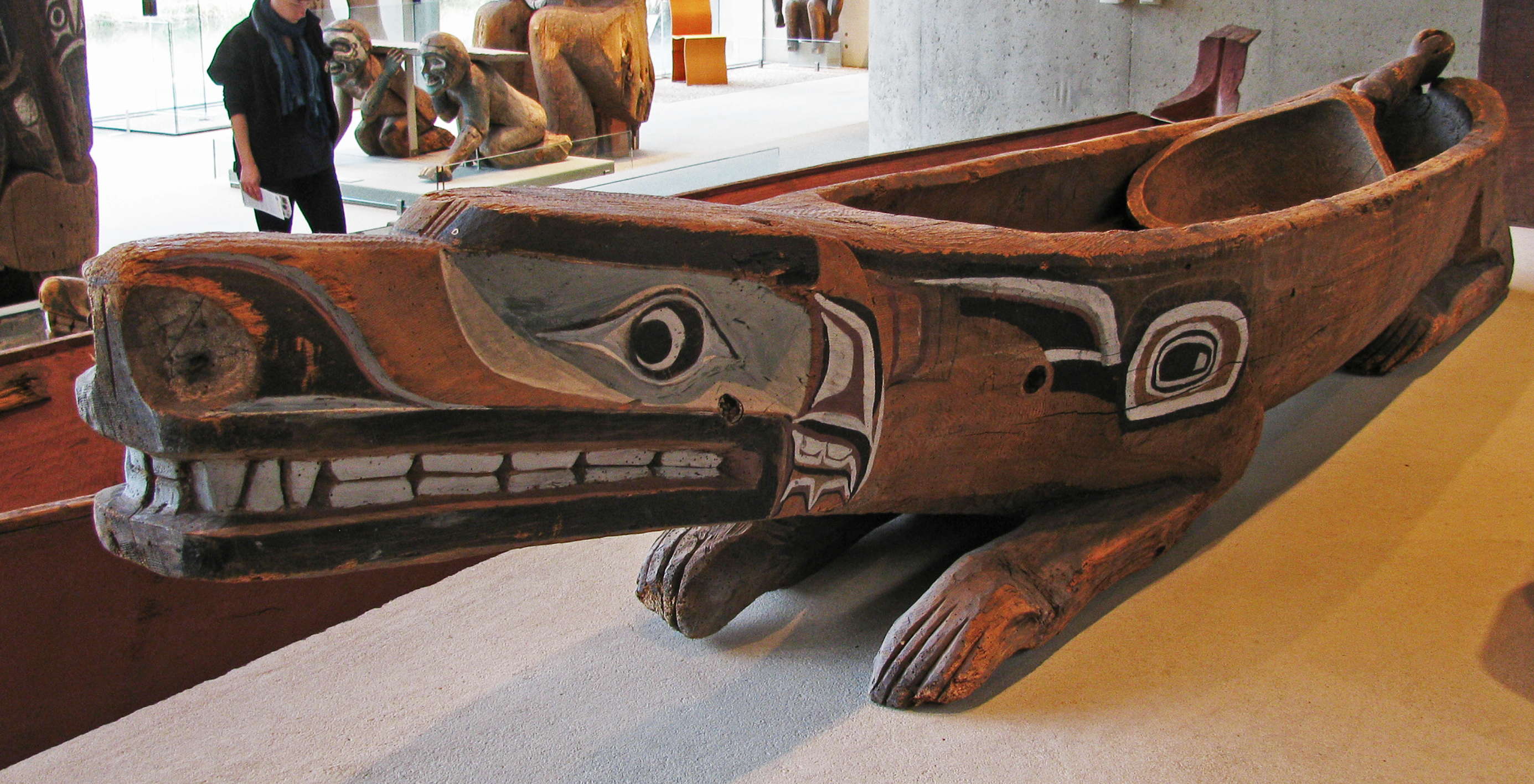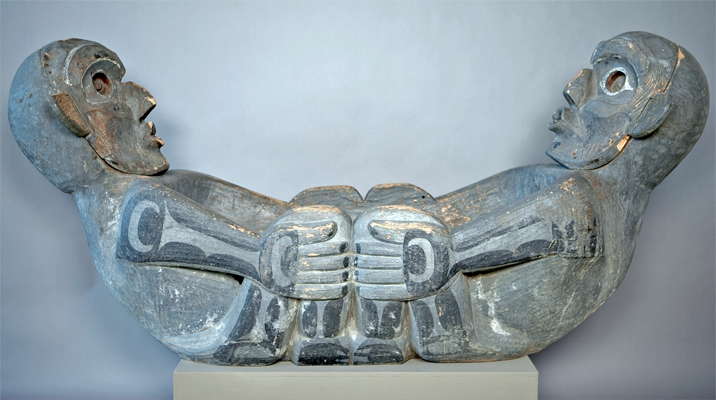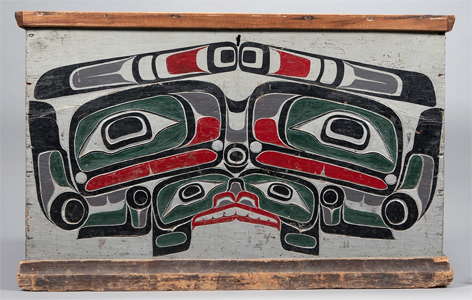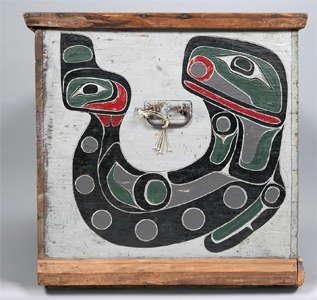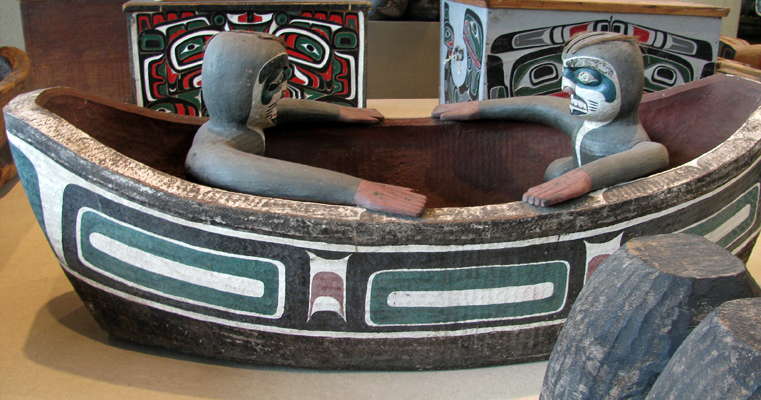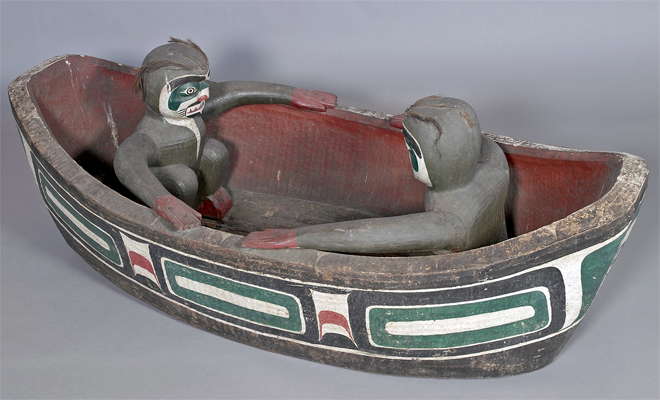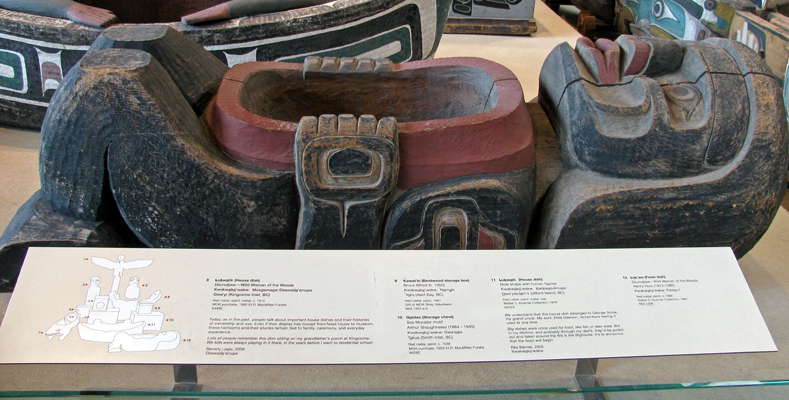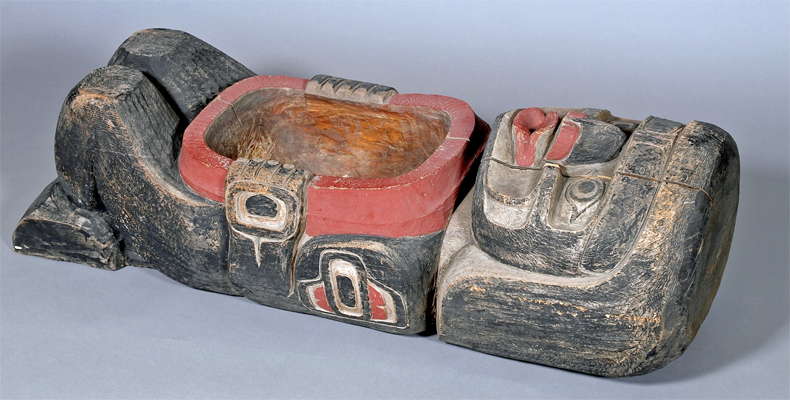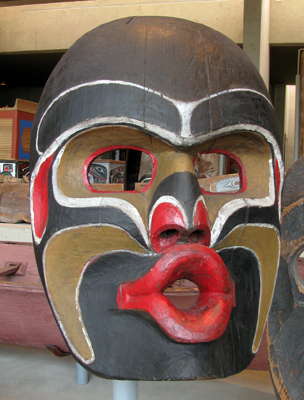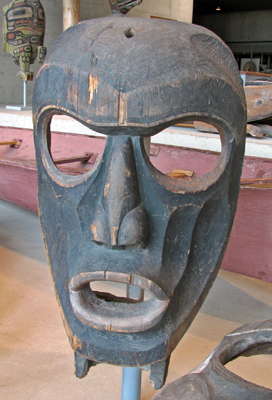Back to Don's Maps
 Back to Archaeological Sites
Back to Archaeological Sites
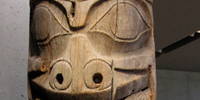 Back to Pacific NW Coast index
Back to Pacific NW Coast index
The Potlatch - First Nations of the Pacific Northwest
A potlatch is a gift-giving festival and primary economic system practiced by indigenous peoples of the Pacific Northwest Coast of Canada and United States. The word comes from the Chinook Jargon, meaning 'to give away', originally from the Nuu-chah-nulth word p̓ačiƛ, to make a ceremonial gift in a potlatch. It went through a history of rigorous ban by both the Canadian and United States' federal governments, and has been the study of many anthropologists. At potlatch gatherings, a family or hereditary leader hosts guests in their family's house and holds a feast for their guests.
The main purpose of the potlatch is the re-distribution and reciprocity of wealth. Different events take place during a potlatch, like singing and dancing, sometimes with masks or the real regalia, such as Chilkat blankets, the barter of wealth through gifts, such as dried foods, sugar, flour, or other material things, and sometimes money. For many potlatches, spiritual ceremonies take place for different occasions. This is either through material wealth such as foods and goods or non-material things such as songs and dances. For some cultures, such as Kwakwaka'wakw, elaborate and theatrical dances are performed reflecting the hosts' genealogy and cultural wealth. Many of these dances are also sacred ceremonies of secret societies. Typically the potlatching is practiced more in the winter seasons as historically the warmer months were for procuring wealth for the family, clan, or village, then coming home and sharing that with neighbours and friends.
Within it, hierarchical relations within and between clans, villages, and nations, are observed and reinforced through the distribution or sometimes destruction of wealth, dance performances, and other ceremonies. The status of any given family is raised not by who has the most resources, but by who distributes the most resources. The hosts demonstrate their wealth and prominence through giving away goods. Chief O'wax̱a̱laga̱lis of the Kwagu'ł describes the potlatch in his famous speech to anthropologist Franz Boas, 'We will dance when our laws command us to dance, and we will feast when our hearts desire to feast. Do we ask the white man, 'Do as the Indian does?' It is a strict law that bids us dance. It is a strict law that bids us distribute our property among our friends and neighbors. It is a good law. Let the white man observe his law; we shall observe ours. And now, if you come to forbid us dance, be gone. If not, you will be welcome to us.'
Celebration of births, rites of passages, weddings, funerals, namings, and honouring of the deceased are some of the many forms the potlatch occurs under. Although protocol differs among the Indigenous nations, the potlatch will usually involve a feast, with music, dance, theatricality and spiritual ceremonies. The most sacred ceremonies are usually observed in the winter. It is important to note the differences and uniqueness among the different cultural groups and nations along the coast. Each nation, tribe, and sometimes clan has its own way of practicing the potlatch with diverse presentation and meaning. The potlatch, as an overarching term, is quite general, since some cultures have many words in their language for various specific types of gatherings. Nonetheless, the main purpose has been and still is the redistribution of wealth procured by families.
Text above: Wikipedia
Feasting and Display
Carved 'house dishes' are part of an ongoing practice of feasting and display by First Nations families on the Northwest Coast.
These great vessels are known by the Kwakwaka'wakw people as lukwalil, or 'feasting dish on the floor of the house.'
Carved in the shape of an animal or supernatural being, the dishes embodied the history and wealth of their owners. The foods they held - fish oil, seal meat, berries - made visible the rights to resources and territories claimed by the chiefly host.
Ɫukwaliɫ (House Dish), Beaver
A6936
Kwakwaka'wakw: Gwa'sala
Takus (Smith Inlet, BC)
Red cedar, paint: ca 1872
MOA purchase, 1953 (H.R. MacMillan funds)
Photo: Don Hitchcock 2012
Source and text: Display, Museum of Anthropology, University of British Columbia
Ɫukwaliɫ (House Dish), Beaver
A6937
Kwakwaka'wakw: Gwa'sala
Takus (Smith Inlet, BC)
Red cedar, paint: ca 1872
MOA purchase, 1953 (H.R. MacMillan funds)
Photo: Don Hitchcock 2012
Source and text: Display, Museum of Anthropology, University of British Columbia
Ɫukwaliɫ (House Dish), Seal
A7237
Kwakwaka'wakw: Gwa'sala
Takus (Smith Inlet, BC)
Red cedar, paint: ca 1860
MOA purchase, 1953 (H.R. MacMillan funds)
Photo: Don Hitchcock 2012
Source and text: Display, Museum of Anthropology, University of British Columbia
Sisiyutl Ɫukwaliɫ (House Dish in form of Sisiyutl)
A4147
Representing the supernatural Sisiyutl, or double-headed serpent, this dish would have made a dramatic entrance when wheeled before guests at a potlatch. It features three horned faces, deeply carved bowls, and huge ladles as tongues.
The dish was commissioned in the early 20th century by Sewid Smith, the Lawitsis chief at Kalugwis on Turnour Island. His son, Peter (Siwidanakwala), recalled that it only ever held gifts of sugar, which were distributed by the chief and his family to their guests.
Charlie James, Yakudlas (ca (1870 - 1938)
Kwakwaka'wakw: Kwagu'l
Takus (Smith Inlet, BC)
Red cedar, paint: ca 1907
MOA purchase, 1953 (H.R. MacMillan funds)
Photo: Don Hitchcock 2012
Source and text: Display, Museum of Anthropology, University of British Columbia
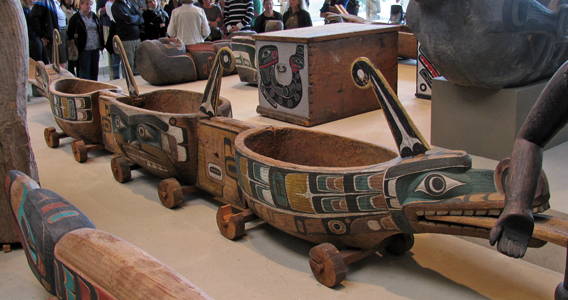
Sisiyutl Ɫukwaliɫ (House Dish in form of Sisiyutl)
A4147
The Sisiyutl is double headed - this is the other end of the Sisiyutl.
Photo: Don Hitchcock 2012
Source: Display, Museum of Anthropology, University of British Columbia
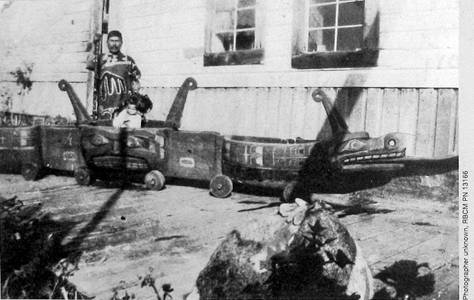
Sewid Smith poses with his Sisiyutl house dish and chiefly regalia, while Dora Speck plays inside the central bowl, ca 1925.
Photo: Unknown, RBCM PN 13166
Source and text: Display, Museum of Anthropology, University of British Columbia
Welcome Figures / Potlatch Figures
As a welcoming gesture to important guests arriving by canoe for a feast or potlatch, a large carved figure of a human is placed at the edge of the beach, facing out to sea. It might have arms outstretched in welcome, or a hand shading its eyes in a scouting manner, watching for the visitors’ arrival.
Text above: http://www.sfu.ca/brc/art_architecture/totem_poles.html
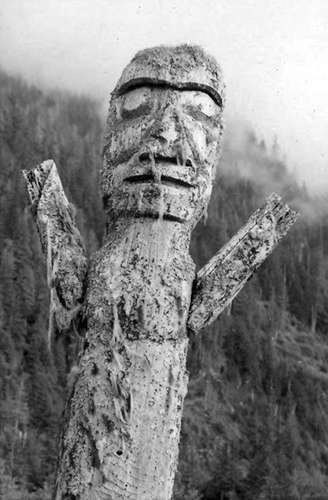
This is a Potlatch Welcome Figure.
Gwa'yi village, also known as Kingcome, is the home of the Dzawada’enuxw (Tsawataineuk) People or 'People of the oolichan place'. It is located a few kilometres up the Kingcome River from the head of Kingcome Inlet .
Gwa'yi holds special significance because it became a refuge for the practice of potlatching during the Canadian government's ban on the gift giving ceremony between 1885 and 1951. During the winter months when these ceremonials occurred, the village of Gwa'yi was especially difficult to access and was situated in such a way that the authorities could not approach by day or night without being seen or heard.
Gwa'yi is also the setting for the book 'I Heard the Owl Call My Name'.
Language group: Kwakwaka'wakw
Village: Gwa'yi (Kingcome)
Photo: © Adelaide de Menil, 1967
Permission and text: Courtesy George MacDonald, Director, Bill Reid Centre for NWC Art Studies at Simon Fraser University, Vancouver, BC.
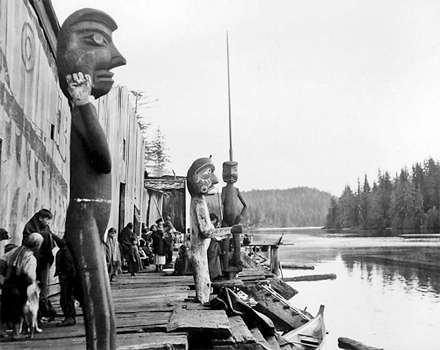
Welcome figures at the Kwakwaka'wakw village of Ba'as (Blunden Harbour).
Photo: © C.F. Newcombe ca. 1900
Source: http://lisajackson.ca/How-a-People-Live
Sea Lion Drum
Identification Number: 863/5
Cylindrical-like shaped wooden drum carved in the form of a sea lion with a wolf-like head, a long body, shallow carved and painted front flippers and a triangular shaped end consisting of two hind flippers formed together with a rectangular tail in between. The head has a long protruding snout with carved eyes, nostrils and bared teeth. The drum is painted black, red and green with Northwest Coast stylised designs.
The drum was to be used with the dance displaying Calvin Hunt's inherited Thunderbird privileges.
Commissioned by the Museum of Anthropology.
Made by Tony Hunt (Maker) in British Columbia, Canada during October 1982
Received from Calvin Hunt (Seller) and Museum of Anthropology Shop Volunteers (Funding source) on October 17, 1982
Height 307 mm, width 2473 mm, depth 246 mm
Culture: Kwakwaka'wakw: Kwagu'l
Photo: Don Hitchcock 2012
Text: http://www.rrnpilot.org/items/23938
Source: Display, Museum of Anthropology, University of British Columbia
1 Kwigwakatola (Eagle on top), Kwakwaka'wakw: 'Namgis, 'Yalis (Alert Bay, BC), A50042
Red cedar, paint; ca 1936 Committee on Totem Poles purchase, 1947. Restored by Ellen Neel and Mungo Martin, 1949 - 1951.
2 Ki'kw (Carved Figures), Kolus - Younger brother of Thunderbird, Kwakwaka'wakw: Tɫat'ɫasikwala Xwamdasbe (Hope Island, BC), A50011 a-b
Red cedar, paint; ca 1880 BC Totem Pole Preservation Committee purchase, 1956
3 Kawat'si (Painted treasure box), Human/Frog Transformation, Richard Sumner (b. 1956) Kwakwaka'wakw: Mamalilikala, Nb3.1489
Red cedar, yew, cedar bark, paint; 1999. Commission funded by MOA Shop Volunteers.
4 ƛahiqs (Bentwood storage box), Nuu-chah-nulth (West coast of Vancouver Island, BC), Nb11.375 a-b
Red cedar; ca 1870, Tom and Frances Richardson Collection, 1995.
5 Galdas (Storage chest), Sea-bear motif, attributed to Tom Patch Wamiss (1895 - 1963), Kwakwaka'wakw: Dzawada'enuxw, Gwa'yi (Kingcome Inlet, BC), A5307
Red cedar, paint; ca 1930, Walter C. Koerner Collection, 1972.
6 K'wilayu (Ladle, 'What you use to feast with'), Sea Lion, Kwakwaka'wakw: Ɫawitsis, Kalugwis (Turnour Island, BC), A8377
Red cedar, paint; ca 1930, MOA purchase, 1963 (H.R. MacMillan Funds).
7 Atɫa'nam (Wolf house dish), Wolf, Kwakwaka'wakw: Kwagu'ɫ, Tsaxis (Fort Rupert, BC), A6557
Red cedar, paint; ca 1900, Committee on Totem Poles purchase, 1947.
8 Ɫukwaliɫ (House dish), Dzunuk'wa - Wild Woman of the Woods, Kwakwaka'wakw: Musgamagw Dzawada'enuxw, Gwa'yi (Kingcome Inlet, BC), A4492
Red cedar, paint, metal; ca 1910, MOA purchae, 1960 (H.R. MacMillan Funds)
9 Kawat'si (Bentwood storage box), Bruce Alfred (b. 1950), Kwakwaka'wakw: 'Namgis, 'Yalis (Alert Bay, BC), Nb3.1355 a-b
Red cedar, paint; 1981, Gift of MOA Shop Volunteers. (absent at the time of photo, and no image is available elsewhere. See http://collection-online.moa.ubc.ca/collection-online/search/item?person%5B0%5D=57&row=1 - Don )
10 Galdas (Storage chest), Sea Monster motif, Arthur Shaughnessy (1884 - 1945), Kwakwaka'wakw: Gwa'sala, Takus (Smith Inlet, BC), A4285
Red cedar, paint; ca 1930, MOA purchase, 1953 (H.R. MacMillan Funds)
11 Ɫukwaliɫ (House dish), Boat shape with human figures, Kwakwaka'wakw: Kwikwasutinuxw, Gwa'yasdam's (Gilford Island, BC), A2524
Red cedar, paint, metal, hair, Walter C. Koerner Collection, 1976.
12 Ɫukwa (Feast dish), Dzunuk'wa - Wild Woman of the Woods, Henry Hunt (1923-1985), Kwakwaka'wakw: Kwagu'ɫ , Nb3.1438
Red cedar, paint; ca 1966, Walter C. Koerner Collection, 1982.
Photo: Don Hitchcock 2012
Source: Display, Museum of Anthropology, University of British Columbia
1 Kwigwakatola (Eagle on top)
A50042
Kwakwaka'wakw: 'Namgis, 'Yalis (Alert Bay, BC),
Red cedar, paint and metal; ca 1936 Committee on Totem Poles purchase, 1947. Restored by Ellen Neel and Mungo Martin, 1949 - 1951.
Large wooden, carved statue painted in the form of an eagle with outstretched wings, mounted on top of a plain wooden pole. The bird has a large protruding yellow beak. Its eyes are black and white surrounded by a green ovoid. The chest is white with a repeating rows of black u-forms depicting feathers. The wings are white with black, green and red u and split u-forms. In the top outer corners of the wings is an eagle head painted in profile. Long tail hangs out the back. Height 140 cmm, width 340 cm, depth 150 cm
Photo: Don Hitchcock 2012
Text: http://www.rrnpilot.org/items/28294 and Display, Museum of Anthropology, University of British Columbia
Source: Display, Museum of Anthropology, University of British Columbia
1 Kwigwakatola (Eagle on top)
A50042
Another version of this eagle.
Noted as belonging to Mr. Cranmer and clansmen. A pair of these sculptures were purchased in 1947 (Barbeau et al call them thunderbirds), however the other bird was stolen shortly after it arrived at UBC, along with the wings of this bird. The piece was repainted and repaired (including the replacement of the wings) by Ellen Neel (1949) and by Mungo Martin (1950-51). Collected by Marius Barbeau and Arthur Price during 1947
Photo and text: http://www.rrnpilot.org/items/28294
2 Ki'kw (Carved Figures)
A50011 a
Kolus - Younger brother of Thunderbird, Kwakwaka'wakw: Tɫat'ɫasikwala Xwamdasbe (Hope Island, BC),
Red cedar, paint; ca 1880 BC Totem Pole Preservation Committee purchase, 1956
Left figure.
Photo: Don Hitchcock 2012
Source and text: Display, Museum of Anthropology, University of British Columbia
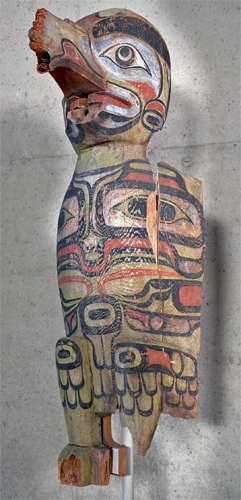
2 Ki'kw (Carved Figures)
A50011 a
Left figure
Large wooden sculpture carved in the form of an eagle and painted yellow or faded green with black, white and red stylized Northwest Coast designs. Appears to be missing wings. Has carved legs and one claw remains. Its chest holds the image of a female frog ? with a labret (A labret is one form of body piercing, usually a piercing that is below the bottom lip, above the chin - Don )
The lower body holds detailing representative of a bird. The head has carved eyes and a protruding nose; the sides have painted ovoids which could possibly be ears.
These carved eagles (parts a-b) were found hidden at the rear of Johnny Wallace's house. They possibly went above the front of the big house. Made in Hope Island, British Columbia, Canada and Xwamdasbe', British Columbia, Canada. Collected by Michael Kew, Wayne Suttles, Wilson Duff and Helen Codere during 1956. Received from British Columbia Totem Pole Preservation Committee during 1956.
Paint, cedar wood and metal, Height 179 cm, width 69cm, depth 61 cm
Photo and text: http://www.rrnpilot.org/items/159304, additional text Wikipedia
2 Ki'kw (Carved Figures)
A50011 a, b
Note that the text above speaks of a labret or lip piercing on the left figure, A50011 a.
I believe that this is not a labret as such, but simply a socket to hold a peg or dowel to fix the lower beak (now missing) on to the head, as a separately carved feature, as may be seen in the right hand figure, A50011 b, on the right of this pair of photos - Don
Photo: http://www.rrnpilot.org/items/159304, http://www.rrnpilot.org/items/159271
2 Ki'kw (Carved Figures)
A50011 b
Kolus - Younger brother of Thunderbird, Kwakwaka'wakw: Tɫat'ɫasikwala Xwamdasbe (Hope Island, BC), A50011 b
Red cedar, paint; ca 1880 BC Totem Pole Preservation Committee purchase, 1956
Right figure.
Photo: Don Hitchcock 2012
Source and text: Display, Museum of Anthropology, University of British Columbia
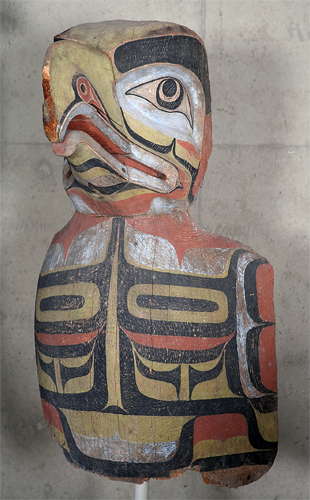
2 Ki'kw (Carved Figures)
A50011 b
Right figure.
Large wooden sculpture carved in the form of an eagle and painted yellow or faded green with black, white and red stylized Northwest Coast designs. Appears to be missing wings and legs. It has carved eyes and a protruding beak. On its chest are large forms that depict feathers. These carved eagles (parts a-b) were found hidden at the rear of Johnny Wallace's house. They possibly went above the front of a big house.
Made in Hope Island, British Columbia, Canada and Xwamdasbe', British Columbia, Canada Collected by Michael Kew, Wayne Suttles, Wilson Duff and Helen Codere during 1956. Received from British Columbia Totem Pole Preservation Committee during 1956
Metal, paint and cedar wood
Photo and text: http://www.rrnpilot.org/items/159271
3 Kawat'si (Painted treasure box)
Nb3.1489
Human/Frog Transformation, Richard Sumner (b. 1956) Kwakwaka'wakw: Mamalilikala,
Red cedar, yew, cedar bark, paint; 1999. Commission funded by MOA Shop Volunteers.
Bentwood box (parts a-b) painted and carved with human/frog transformation. The box (part a) has a lid (part b ) with cedar rope lashings and yew wood toggle. The front edge of the lid is tall while the rest is flat.
Three sides of the box are carved to have round fluting, the front has a circular transformation design framed in a blue painted rectangle; corners and top edge of sides are painted red-brown. Corners have been steamed, kerfed, and bent. Pegs at bottom are wooden. Rope lashings toggle together over lid.
Cedar wood, adhesive, mineral oil, yew wood, cedar bark and paint
Part a: height 544 mm, width 482 mm, depth 456 mm
Part b: height 128 mm, width 496 mm, depth 469 mm
Made by Richard Sumner in Saltspring Island, British Columbia, Canada during 1999 and funded by the Museum of Anthropology Acquisitions Budget (Funding source) on December 13, 1999
Photo (left): Don Hitchcock 2012, (right) http://www.rrnpilot.org/items/28179
Text: http://www.rrnpilot.org/items/28179
Source and text: Display, Museum of Anthropology, University of British Columbia
4 ƛahiqs (Bentwood storage box)
Nb11.375 a-b
Nuu-chah-nulth (West coast of Vancouver Island, BC), Nootka culture.
Red cedar; ca 1870, Tom and Frances Richardson Collection, 1995.
Bentwood box (part a) with a lid (part b). All four sides made from a single cedar board, steamed and bent into three right angle corners. The open seam is sewn together with strips of sinew. Straight sides, fluted on ends and one side. A separate cedar board is nailed on to make a bottom. Lid is constructed of a cedar board with one side having an upturned flaring edge. Box has been painted dark brown.
Cedar wood, sinew and paint
Part a: Height 564 mm, width 652 mm, depth 497 mm
Part b: Height 101 mm, width 682 mm, depth 503 mm
Condition: good. Made in British Columbia, Canada, received from Thomas R. Richardson (Donor) on June 19, 1995
Photo and text: http://www.rrnpilot.org/items/26625
Text: Display, Museum of Anthropology, University of British Columbia
5 Galdas (Storage chest)
A5307
Sea-bear motif, attributed to Tom Patch Wamiss (1895 - 1963), Kwakwaka'wakw: Dzawada'enuxw, Gwa'yi (Kingcome Inlet, BC),
Red cedar, paint; ca 1930, Walter C. Koerner Collection, 1972.
Cedar chest with a cedar lid hinged with metal. The lid and the base are painted black while the sides are white with a slightly carved design, painted black, red and green in Northwest Coast stylised forms. The front has a front facing, distributive design depicting an aquatic animal. A smaller sea bear (possibly) on both ends. Back plain black. Height 603 mm, width 1006 mm, depth 543 mm
Bentwood boxes were used primarily for storage of food, implements, clothing and valuables. They were also used for cooking and serving food. They sometimes served as furniture or room dividers. They were also used as trade goods or gifts, and were symbols of wealth and prestige. Boxes used for ceremonial purposes were usually more highly decorated than those for everyday use.
Photo and text: http://www.rrnpilot.org/items/4678
Text: Display, Museum of Anthropology, University of British Columbia
6 K'wilayu (Ladle, 'What you use to feast with')
A8377
Sea Lion, Kwakwaka'wakw: Ɫawitsis, Kalugwis (Turnour Island, BC) before 1960.
Red cedar, paint; ca 1930, MOA purchase, 1963 (H.R. MacMillan Funds).
Large wooden ladle with a deep bowl and a cylindrical shaped handle carved in the form of a sea-lion. The bottom of the mouth attaches to the top of the spoon. The nose, eyes and mouth are carved, there is shallow engraving for side fins. The end of the handle consists of the back fins formed together in an oval-like shape. Painted black but there are traces of white and orange paint.
Ladles were used to serve food from large feast dishes into smaller vessels. Feasting occurred at winter dance ceremonies and potlatches, as well as on other important social occasions. The figures represented on feast dishes and ladles were supernatural and other figures which families owned the rights to display, through their histories and origins, as family privileges. The Sea-lion is usually represented in Kwakwaka'wakw sculpture with an elongated and rounded snout, and flippers or fins.
Height 188 mm, width 444 mm, length 1323 mm
Photo and text: http://www.rrnpilot.org/items/17201
Text: Display, Museum of Anthropology, University of British Columbia
7 Atɫa'nam (Wolf house dish)
A6557
Wolf, Kwakwaka'wakw: Kwagu'ɫ, Tsaxis (Fort Rupert, BC).
(Note that this photo also shows item 6, the K'wilayu (Ladle, 'What you use to feast with') shown in the photograph above, in its normal position inside the feast dish - Don )
Red cedar, paint; ca 1900, Committee on Totem Poles purchase, 1947.
Carved, wooden feast dish in the shape of a crouching wolf with its back hollowed out to make a long, deep bowl. Black and white painted ovoid denotes shoulder joint. The eyes, nose and teeth are carved and painted black and white. The paws are carved and act as support to the bowl. Sides are finely adzed in horizontal lines, while the interior is more boldly hollowed out to form a huge dish. There are two square holes on the wolf’s head possibly for the attachment of ears. The bright paint appears to have been added later, as there are severely faded images along the side of the dish.
Large feast dishes were used primarily to hold food served to guests at winter dance ceremonies and potlatches, as well as on other important social occasions. They also were symbols of wealth and prestige. The figures represented on feast dishes were named.
Wolf is often represented in Kwakwaka'wakw sculpture with an elongated and squared snout, and pointed ears.
Collected by Marius Barbeau and Arthur Price during 1947. Received from Committee on Totem Poles (Transferring institution) during 1947
Height 543 mm, width 3202 mm, (???? less then 1000 mm in width I would have thought - Don ) length 5110 mm
Field Collector: Marius Barbeau and Arthur Price. Received from Committee on Totem Poles (Transferring institution) during 1947.
Photo: Don Hitchcock 2012
Source and text: Display, Museum of Anthropology, University of British Columbia
Text: http://www.rrnpilot.org/items/17070
The following is adapted from the The University of Washington Student Newspaper at http://www.thedaily.washington.edu/1996/2/29/wakw022996/
For the Kwakwaka'wakw, the world was filled with many spirits. These spirits, in the form of feast dishes, are now on display at the Burke Museum.
The Kwakwaka'wakw, an indigenous people of the Pacific Northwest, saw no distinction between human and animal: for them, life was universal. The change in appearance of various creatures was simply regarded as a mask change. Animals such as the wolf and the killer whale held special spiritual significance, and shamans in the tribe were able to become intimate with spirits that could help and assist the people.
Both sexes from various tribes trained from their childhood to meet their spirit animal. Once a girl reached puberty, she generally abandoned her vision quest if she had not acquired a spirit animal, but men continued searching for a spirit throughout their adulthood.
While there was a certain set of rites to perform for getting a spirit's attention, most spirits were temperamental. Shamans weren't powerful because they held power themselves, but because they had been chosen by spirits. A shaman didn't find the spirit; the spirit found the shaman.
The Kwakwaka'wakw shamans held ceremonial positions, rather than being healers. Much of their 'job' consisted of the performance of dances and songs for their spirit animal at parties. These shamans were collectively called the numayns and they were bound together by similar visions. It was their privilege to hold the parties, known as 'potlatches'.
The potlatch was tailored to whatever spirit animal the numayns were able to channel. Only the numayns could handle the large feast dishes, carved in the shape of the spirit animal, which held food such as dried fish, stews, fruit soups, kelp and herring. Those attending a potlatch usually brought their own small food bowl.
A person could rise in status in society if they were able to channel a powerful spirit. The wolf, known to take people away from the tribe into the wilderness to teach them the wolf dance, was one particularly powerful spirit. The person possessed needed to be captured and tamed by humans again in order to become a numayn. The wolf feast dish was part of the numayn's potlatch. The Dzoonokwa (pronounced zunaqua) is another powerful spirit being to the Kwakwakwa' wakw. It is the sasquash. If a numayn could trick the Dzoonokwa, great wealth could be obtained.
With the feast dishes are a set of ladles in the form of the sea serpent, Sisootl. This spirit was particularly important to the warriors of the tribe because a favourable encounter with it could make that warrior invulnerable.
8 Ɫukwaliɫ (House dish)
A4492
Dzunuk'wa - Wild Woman of the Woods, Kwakwaka'wakw: Musgamagw Dzawada'enuxw, Gwa'yi (Kingcome Inlet, BC)
Red cedar, paint, metal; ca 1910, MOA purchae, 1960 (H.R. MacMillan Funds)
Large, wooden feast dish carved in the form of two matching, slightly-reclined Dzunuk'wa figures. They face each other with their hands clutching their bent legs; deeply hollowed centre. Thick black lines, painted over a grey background outline the anatomical forms. Mask-like faces are nailed onto hollow heads. Protruding ears are attached separately. The lips are pursed and protrude, the red eyes are recessed, and large black defined eyebrows and high cheekbones are carved into the faces.
Large feast dishes were used primarily to hold food served to guests at winter dance ceremonies and potlatches, as well as on other important social occasions. They also served as symbols of wealth and prestige. The figures represented on feast dishes were family crests and privileges. Important feast bowls were named.
Pursed lips indicate Tsonoqua, a female member of a family of giants believed to have lived far in the woods. She was reported to be both powerful and wealthy, as well as slow and stupid. She was reported to steal children; her lips are red from their blood. Her recessed eyes indicate that she cannot see well. Crescents in her eyes indicate she is blind or asleep.
This dish was important in the cultural context of ceremony, potlatch and status. The database says that it was probably made sometime from the 1860s to the 1890s, although ca 1910 was given on the museum card as the date for the actual item on display.
Received from H. R. MacMillan (Funding source) and Edward F. Meade (Seller) during July 1960
Photo and text: http://www.rrnpilot.org/items/17069
Text: Display, Museum of Anthropology, University of British Columbia
10 Galdas (Storage chest)
A4285 a-b
Sea Monster motif, Arthur Shaughnessy (1884 - 1945), Kwakwaka'wakw: Gwa'sala, Takus (Smith Inlet, BC)
Red cedar, paint; ca 1930, MOA purchase, 1953 (H.R. MacMillan Funds)
Wooden storage chest (parts a-b) with a brown wood frame bottom, metal side handles and a flat wood lid (part b). The box (part a) is painted on three sides with a white background and Northwest Coast stylised figures in black, green, grey and red. The front design depicts a front facing whale with its body split to either side, its dorsal fin on top and its tail fin at the bottom. The ends each have a whale in profile.
Received from Joe Johnny (Seller) and H. R. MacMillan (Funding source) on June 16, 1953
Materials: wood, paint, cotton fibre and metal.
Part a: Height 621 mm, width 1023 mm, depth 638 mm
Part b: Height 32 mm, width 1021 mm, depth 663 mm
Photo and text: http://www.rrnpilot.org/items/158677
Text: Display, Museum of Anthropology, University of British Columbia
11 Ɫukwaliɫ (House dish)
A2524
Boat shape with human figures, Kwakwaka'wakw: Kwikwasutinuxw, Gwa'yasdam's (Gilford Island, BC), A2524
Red cedar, paint, metal, hair, Walter C. Koerner Collection, 1976.
Carved wooden dish shaped like a canoe, with two carved and painted human figures crouched inside, facing one another. The canoe is painted black with a wide white band that has a repeating pattern of red u-forms in between green and white ovoids; ends of the canoe have a green tail-like design. Both of the figures are painted black with white faces, a green band across the eyes, red nostril and black facial hair. On top of their heads are three strips of beaver (?) fur. The inside of the canoe is painted red.
Photo: Don Hitchcock 2012
Source and text: Display, Museum of Anthropology, University of British Columbia
Text: http://www.rrnpilot.org/items/17038
11 Ɫukwaliɫ (House dish)
A2524
(Note that this photograph is taken from the opposite side to mine above, given the 'hair' patterns, the shapes of the ends of the canoe, and the white and red icon differences - Don )
Height 653 mm, length 1822 mm, beam 814 mm
The artefact is similar in size to dishes used for large portions of food which could then be served into smaller dishes for the use of four to six people.
Cultural Context: ceremonial; potlatch; status
Received from Walter C. Koerner (Donor) on April 8, 1976
Photo: http://www.rrnpilot.org/items/17038
Source and text: Display, Museum of Anthropology, University of British Columbia
Text: http://www.rrnpilot.org/items/17038
12 Ɫukwa (Feast dish)
Nb3.1438
Dzunuk'wa - Wild Woman of the Woods, Henry Hunt (1923-1985), Kwakwaka'wakw: Kwagu'ɫ
Red cedar, paint; ca 1966, Walter C. Koerner Collection, 1982.
Dzunuk'wa feast dish carved from a single piece of wood in shape of reclining figure, Dzunuk'wa (Tsonoqua), with head at one end; centre is deep ovoid bowl and opposite end has drawn up knees with block-like feet. Head is deeply carved with hair outlined; nose, pursed mouth and chin in higher relief than eyes and cheeks. Cheek band is mid-height. Head cuts off sharply at chin. Bowl has hands on either side with carved ovoid shape on palm and ovoids with split u's and ovoid on shoulder area. Painted black with red details on mouth, nostrils, bowl rim and with white shoulder detail. White on palm. Adze marks in longitudinal lines. Flat on bottom.
Feast dishes were used at ceremonial occasions. They were part of a household's crest belongings and important ones were named. Food was dished out of feast bowls by the hosts' family into smaller serving dishes. These were then distributed to the guests in the correct order of rank, established for the particular occasion.
Photo: Don Hitchcock 2012
Source and text: Display, Museum of Anthropology, University of British Columbia
Text: http://www.rrnpilot.org/items/16611
12 Ɫukwa (Feast dish)
Nb3.1438
Feast dishes symbolised abundant resources. Dzunuk'wa is a member of the large family of giants who live in the far away mountains and woods. Black in colour, with bushy, unkempt hair and a pursed mouth through which she utters the cry Hu! Hu!, she is a terrifying and threatening creature. She carries a huge basket on her back in which she puts the disobedient children she steals, taking them to her home to eat them. However, the children usually outwit her, as she is vain, stupid and clumsy.
In another aspect, Dzunuk'wa is the possessor of the 'Water-of-Life', a gift she would bestow on people fortunate enough to encounter and overcome her. Her most important role is the bringer of wealth and good fortune. In the Winter Ceremonies, Dzunuk'wa appears in two forms. As a dancer in the T'seka, she is a shaggy lumbering creature with half shut eyes. She is not awake enough to dance the normal four circuits around the fire, but staggers in the wrong direction and when escorted to her seat, she falls asleep. In her other role, she carries a basket of coppers that she gives to the Chief who is selling or giving them away.
Made by Henry Hunt in Tsaxis (Fort Rupert) British Columbia, Canada during 1966.
Received from Walter C. Koerner (Donor) on October 21, 1982
Height 441 mm, width 1577 mm, depth 506 mm
Photo and text: http://www.rrnpilot.org/items/16611
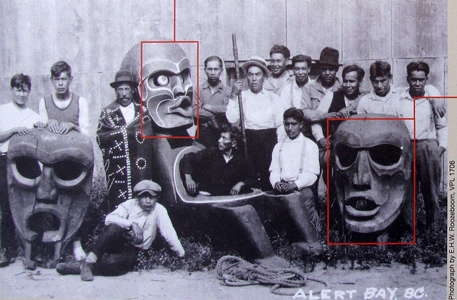
A group of Musgamagw Dzawada'enuxw men poses in and around an enormous Dzunuk'wa feast dish in Kingcome Inlet, British Columbia, ca 1926. Note the eyes in the central mask or feast dish lid.
The body of the dish is in the collection of the Glenbow Museum, Calgary.
Kwakwaka'wakw community members Mikael Willie, Chief Adam Dick, and William Wasden Jr. have identified the individuals in the photograph:
Left to right: Bill Wilson, Sam Webber, Chief Iwakalas (Jim Humchitt or 'Adatana', likely the owner of the dish), Head Chief Kodalagalis (Dick Webber, holding staff), Harry Jack, Alfred Coon (kneeling), William Webber, William Dawson, Jim King, Albert Dawson, and Shorty James.
Photo: E.H.W. Roozeboom, VPL 1706
Source and text: Display, Museum of Anthropology, University of British Columbia
Gugwame' sa Dzunuk'wa
A2522
(Face of Dzunuk'wa feast-dish cover), Kwakwaka''wakw: Musgamagw Dzawada''enuxw, Gwa'yi (Kingcome Inlet, BC)
Dzunuk'wa (or Tsonoqua) figure with pursed lips and heavy eyebrows. The feast dish lid is painted black with white outlining the eyebrows, brown around the red-rimmed eye holes, white bordering the eye sockets, red nostrils bordered around the top with white, brown bordered with white under the cheeks and down the sides of the jaw, red at the temples, and red on the lips.
Used as a feast dish lid. The carvings used were usually mythical beings associated with the history of the family who had the right to use representations of them as family crests.
Dzunuk'wa is usually recognised by her blackened face, sunken eyes and cheeks, and pursed lips. Dzunuk'wa was a female giantess who inhabited the distant forest and mountains. She had a distinctive cry 'hu, hu' and was particularly threatening to children. She could also be benevolent in some aspects. Used as a crest she was associated with wealth and power.
This Dzunuk'wa dish lid appears in the historical photo shown above (ca 1926) of men at Kingcome Village posing with a Dzunuk'wa dish and another MOA lid A4342. It is now missing its eyes and was repainted. Individuals in the photo have been identified by Adam Dick, Mike Willie, and William Wasden, Jr. William said that Chief Iwakalas, or Jim Humchitt (“Adatana”), was probably the owner of the dish, and therefore of the lid that fit it.
Received from Walter C. Koerner (Donor) on April 8, 1976
height 920 mm, width 640 mm, depth 280 mm
Accession number: 336/1
Photo (left): Don Hitchcock 2012
Photo (right): http://www.rrnpilot.org/items/11927
Source: Display, Museum of Anthropology, University of British Columbia
Text: http://www.rrnpilot.org/items/11927
Gugwame' sa Dzunuk'wa
A4342
(Face of Dzunuk'wa feast-dish cover), Kwakwaka''wakw: Musgamagw Dzawada''enuxw, Gwa'yi (Kingcome Inlet, BC)
Large wooden mask-like shaped lid carved in the form of Dzunuk'wa (Tsonoqua). She has a large open mouth and eyes, pursed lips, shallow cheeks and a carved nose. Painted red around the eyes and the mouth; face painted black.
Used as a feast dish lid. The carvings used were usually mythical beings associated with the history of the family who had the right to use representations of them as family crests.
Tsonoqua is usually recognised by her blackened face, sunken eyes and cheeks, and pursed lips. Tsonoqua was a female giantess who inhabited the distant forest and mountains. She had a distinctive cry 'hu, hu' and was particularly threatening to children. She could also be benevolent in some aspects. Used as a crest, she was associated with wealth and power.
This lid appears in a historical photo ca 1926 of men at Kingcome Village posing with a Dzunuk'wa dish and another MOA lid A2522.
Made in Kingcome Inlet, British Columbia, Canada and Gwa'yi, British Columbia, Canada before 1926
Received from H. R. MacMillan (Funding source) and Tom Patch Wamiss (Seller) during May 1953
Height 1171 mm, width 674 mm, depth 304 mm
Accession number 1895/1
Photo: Don Hitchcock 2012
Source: Display, Museum of Anthropology, University of British Columbia
Text: http://www.rrnpilot.org/items/4455
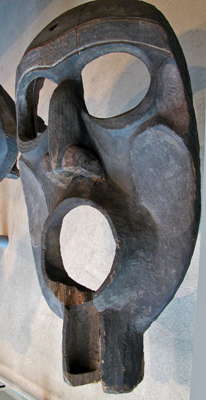
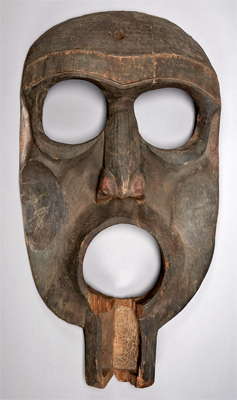
Gugwame' sa Dzunuk'wa
Nb3.1352
(Face of Dzunuk'wa feast-dish cover), Kwakwaka'wakw
Large carved, dark brown head with pronounced features like hollow cheeks and eyes, pursed lips, elongated slightly hooked nose and one thick double-arched eyebrow over both eyes. Back hollowed out: two joined pieces form oval tapering to base that has neck-like projection hollowed out in front.
The centre of the forehead has a borehole, and there are nails hammered into the top of the head. There is some red pigment on the nose and temples. The forehead, eyebrow, and nose are textured by small diagonal cuts in surface.
In ceremonials Tsonoqua appears as a feast dish figure and as masks worn in dances. These are often of giant size. Also as 'gikaml', chief's mask, which is usually of moderate size. The giantess, Tsonoqua, has a character which is threatening; long, bushy, unkempt hair, either slitted eyes or large open sockets, and pursed mouth through which she utters the paralysing cry 'hu hu'. Her face is all black with heavy eyebrows. She is a giver of wealth, power, and good fortune, and is a family crest figure. Another aspect of Tsonoqua was to control the magic 'water of life', a gift she bestowed on a family that wrested her secrets from her. Her importance may be seen in her magical Sisiutl house beams and posts with many filled boxes of treasure within. She is one of a large family of giants who lived in the faraway mountains and woods. A myth tells of the basket she carried on her back in which she collected children, taking them home to eat. The children usually outwitted her, however, because she was slow-moving.
Height 1230 mm, width 675 mm, depth 235 mm
Made in British Columbia, Canada before 1900, Collected during 1925, received from F. Wastell (Donor) on February 7, 1983
Accession number: 851/10
Photo (left): Don Hitchcock 2012
Photo (right): http://www.rrnpilot.org/items/12826
Source: Display, Museum of Anthropology, University of British Columbia
Text: http://www.rrnpilot.org/items/12826
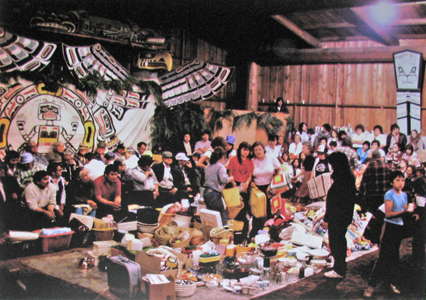
Gifts being distributed to guests at a potlatch given by Tlakwagila (W.T. Cranmer).
Alert Bay, 1983.
'If my ancestors from two hundred years ago were able to be with us today, I often wonder what they would think of a contemporary potlatch. Would they be able to recognize what we do as being related to what they did? Would they pity us for having lost so much, or be proud that we are still here?
I think that after recovering from the shock of seeing so many changes, not only in the potlatch, but in all aspects of our lives, they would tell us that under the circumstances, we are not doing too badly. They would also urge us to keep strengthening what we have, if we are to survive and keep on having our good times.'
Photo: Vickie Jensen
Text: Gloria Cranmer Webster, 1991, Namgis
Source: Display, Museum of Anthropology, University of British Columbia
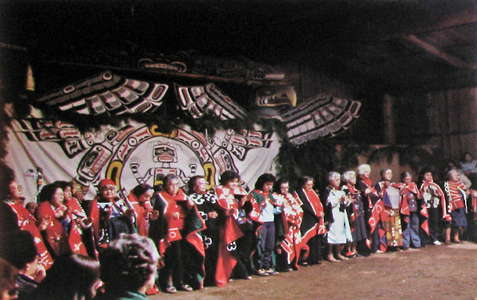
Dancers at a potlatch given by Tlakwagila (W.T. Cranmer), at Alert Bay, 1983.
'The reasons for giving potlatches are the same as they were in the past - naming children, mourning the dead, transferring rights and privileges, and less frequently, marriages or the raising of memorial totem poles. Times for potlatching that would not have been known in earlier days were the opening of the Kwagulth Museum in Cape Mudge in 1979 and of the U'mista Cultural Centre in 1980. Our hearts were certainly glad on both those occasions.'
Photo: Vickie Jensen
Text: Gloria Cranmer Webster, 1991, Namgis
Source: Display, Museum of Anthropology, University of British Columbia
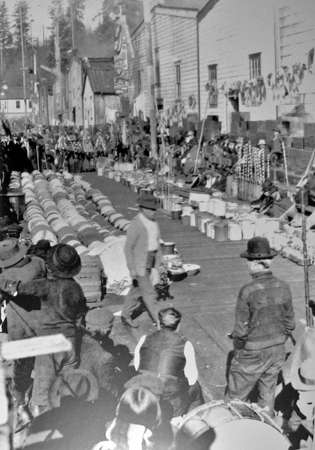
Gifts to be distributed to guests at a potlatch given by Bob Harris ca 1914, Alert Bay
Photo: J. Welsh, RBCM PN 2307-b
Source: Display, Museum of Anthropology, University of British Columbia
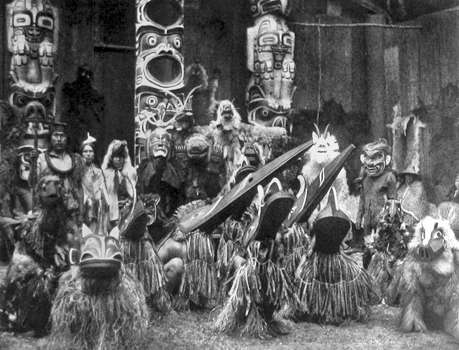
Dancers posing in potlatch regalia, Fort Rupert, 1914.
Photo: Edward S. Curtis
Source: Display, Museum of Anthropology, University of British Columbia
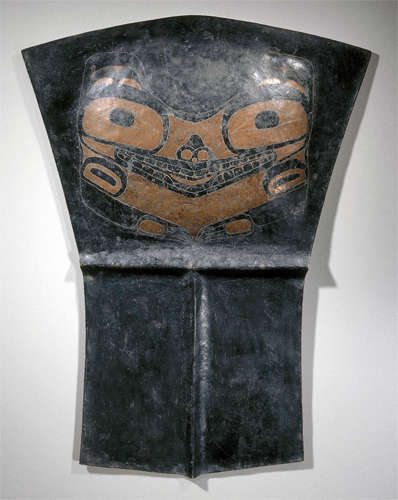
Copper (Tlakwa)
Culture: Haida, Native American
Medium: Copper alloy, pigment
Place Made: Skidegate, Queen Charlotte Islands, British Columbia, Canada
Dates: 19th century
Dimensions: 29 3/4 x 22 1/4 x 1 3/4 in. (756 x 565 x 44 mm)
Collections:Arts of the Americas
Accession Number: 16.749.1
Credit Line: Museum Collection Fund
Rights Statement: Creative Commons-BY
Image: overall, 16.749.1_SL1.jpg. Brooklyn Museum photograph
The object,known as a 'copper', was cut into the shape of a shield from a flat sheet of copper alloy and hammered out to produce the animal face on the upper section and the ridge on the lower section. The upper section of this copper contains either the head of a bear or a beaver and has exposed metal as well as black and white painted areas. The delineation of the animal head on the upper area was achieved by scratching through painted and exposed metal areas. The lower section of the copper has two black painted panels with a vertical ridge. On the back of the object, there is some corrosion that is stable. The object is in good condition with minor surface scratches overall. Coppers were used as status symbols and were important economical commodities for their owners. The owner could break off part of one during a potlatch ceremony to demonstrate his or her largesse although this one shows no signs of having been used in this way.
Source: http://www.brooklynmuseum.org/opencollection/objects/17313/Copper_Tlakwa#
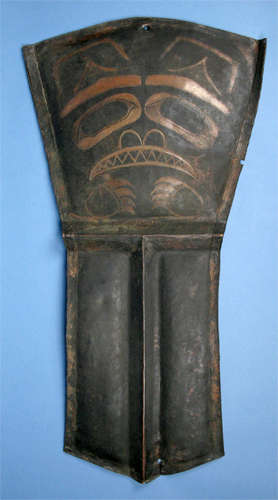
Copper
Culture: Kwakwaka'wakw
Made in Vancouver Island, British Columbia, Canada
Received from Victor Justice Evans
Identification Number E360996-0
Length 800 mm, width 683 mm
Holding Institution: National Museum of Natural History
Source: http://www.rrnpilot.org/items/294750
The copper, which derives its English name from the metal of its manufacture, is an item that represents great wealth and prestige among the people of northern Vancouver Island and northward to Alaska. The copper's characteristic shape has a flared upper half, which may carry a design; the lower half has ridges hammered into a T shape.
With an average height of about 70 cm (28 inches), excluding miniatures, coppers of the past were made from sheet copper - often of the type used for sheath ing the wooden hulls of saillng ships - and were acquired in trade. The metal itself symbolised wealth and high rank. Northern chiefs proclaimed their rank and lineage by displaying coppers at a potlatch. Each copper had a name and a history, and represented a specific value. Among the Kwakiutl (Kwakwaka'wakw), a chief could take revenge on anyone who had insulted him or his family by publicly and ceremonially breaking off a section of a copper and presenting it to the offender. A copper could be broken several times and repaired, adding to its history and value.
Throwing a copper into a fire or into the sea was a conspicuous gesture of disregard for one's enormous wealth. Coppers of great value could be used towards purchasing slaves, a stand of fine cedars, hunting lands, or other food resources or property. One or more coppers might be carved or painted on a pole to proclaim a person's rank and status or, more rarely, be nailed to a mortuary or memorial pole.
Additional text: Stewart 1993
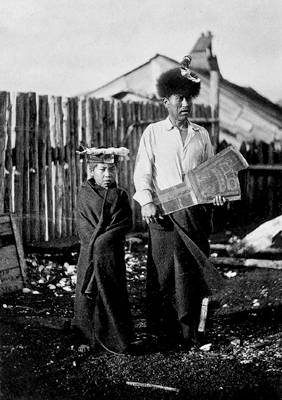
Nakwaxda'xw chief Tuglidi giving away a copper in honour of his son, Fort Rupert, 1894.
Photo: O.C. Hastings, AMNH 106707
Source and text: Jonaitis (1991)
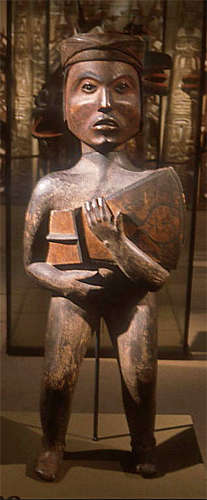
Chief with a copper, Museum of Ethnology, Berlin.
On display at Berlin's Museum of Ethnology in Germany is a magnificent sculpture in red cedar of a Kwakwaka'wakw chief with a copper, collected by Johan Adrian Jacobsenon in 1881. During the most intense period of museum collecting between 1880 and 1920, the Kwakwaka'wakw population reached its lowest point. Pre existing indigenous social and legal systems were ignored as the colonial government encouraged the alienation of Kwakwaka'wakw territories by settlers and entrepreneurs.
Photo: ©Ron Johnson
Source and text: http://www.firstnations.eu/fisheries/kwakwakawakw-namgis.htm
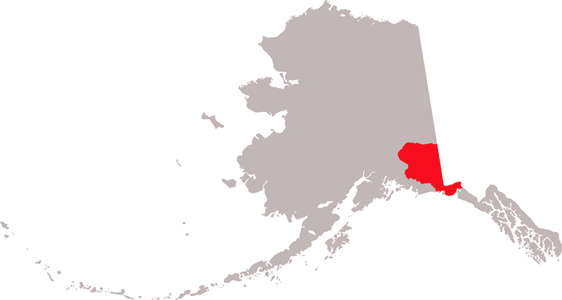
There were several sources of native copper available to the First Nations before europeans came to the Pacific Northwest, but much of it came from this area shown in red, now known as the Wrangell–St. Elias National Park and Preserve, in Southern Alaska.
Photo: cobaltcigs
Permission: Public Domain
Source: Derived from File:Map_of_Wrangell-St._Elias_National_Park.jpg and File:Gray_alaska.svg, also public domain.
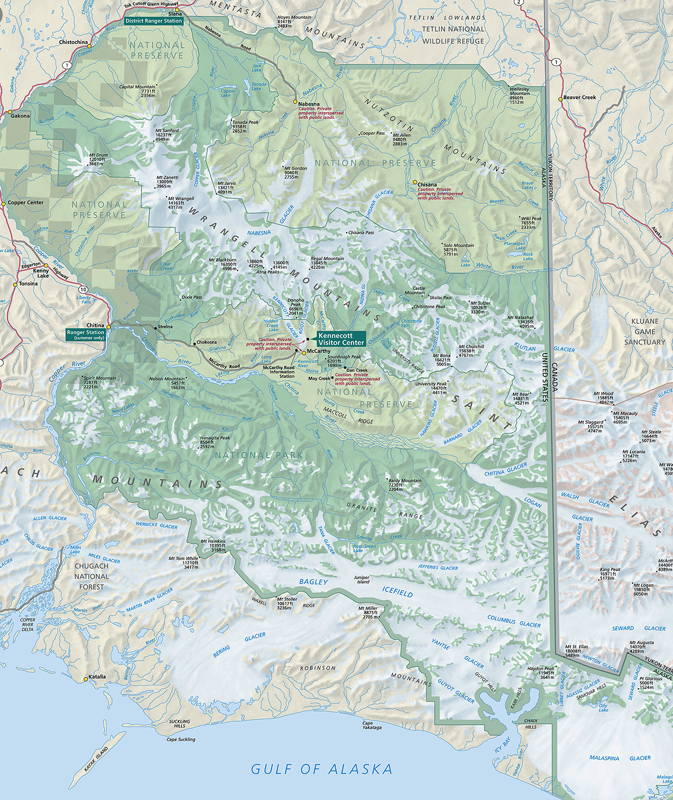
The copper in this area was found as nuggets in the stream beds of the Copper, Chitina, and White Rivers, washed down from the Wrangell and St Elias mountain ranges.
The Copper and Chitina Rivers drain into the Pacific at the Gulf of Alaska, while the White River, also shown on this map draining the northern side of the Wrangell Mountains, flows into the Yukon River which empties into the Bering Sea, north of the Aleutian Peninsula of Alaska.
It should be noted also that the Copper River loops around the northern end of the Wrangell Mountains, and has its ultimate source at the Copper Glacier on the northern side of the Wrangell Mountains.
Photo: http://www.nps.gov/wrst/index.htm
Information adapted from: Cooper (2006)
Copper and iron were both abundant in the latter part of the 18th century. The iron is most likely to have been 'drift iron', that is, iron obtained obtained from the washed up remains of wrecked sailing vessels, presumably Russian, Chinese, or Japanese in origin (de Laguna 1956, 1972; de Laguna et al. 1964)
Northwest Coast Coppers
Though variable in size these shield-like objects could be as large as 91 cm x 61 cm and were found among the Tlingit, Haida, Tsimshian, and Kwakiutl groups of the Northwest Coast (Duff 1981)). Coppers were the most highly valued form of material culture and were considered to be the most desired object of exchange. De Laguna notes that there are 135 Coppers known from museums. At least 125 of these have been subjected to metallographic examination confirming that they were made of non-native commercially produced industrial metal.
Despite the lack of examples made of native copper, the owners of these objects often referred to the Chitina and White River region as the source of the copper. When the use of trade metal was acknowledged by Natives, it was emphasised that those made of native copper were more valuable. Such statements regarding the authenticity and relative value of Coppers may have more to do with their use and validation through exchange and display rather than with the fact of their actual composition being made of native copper.
Initially, copper traded to Natives via Russian posts and vessels of various nations came in the form of kettles, pots, and smaller objects. By the mid-eighteenth century copper sheathing began to be applied to the hulls of British ships in order to prevent sea worm boring and to keep them smooth to promote greater speed. As a result, there was an increase in the amount of sheet copper already carried by ships for repair purposes. When fur traders arrived on the Northwest Coast in the late eighteenth century and discovered that the value accorded copper by indigenous groups was much greater than that warranted based simply on the weight of the metal, copper became important for trade.
Eventually, Coppers were manufactured using sheet copper. Beginning in the 1770s sheet copper, initially from vessels involved in the maritime fur trade, flooded the Northwest Coast. Early in the nineteenth century sheet copper was available from the Russians at Sitka, and by the mid-nineteenth century was also obtained from the English at Victoria. Due to the availability of large quantities of sheet copper from multiple sources, demand for it had dropped significantly as early as the 1790s. Eventually, perhaps not until the mid or latter part of the nineteenth century, the value accorded Coppers decreased. Coppers were first noted in 1787 by Colnett in the southern Queen Charlotte Islands and then in 1793 by Mackenzie in Bella Coola villages. The earliest published account of a Copper is from Lisiansky who was in Sitka, Alaska in 1804.
According to Rickard (1939), Coppers were never made of native copper and appear only after 1774 when the Northwest Coast became inundated with trade copper. While acknowledging that Coppers were largely a post-contact phenomena, based on descriptions provided by informants in Yakutat Bay, de Laguna (1972) suggests that smaller forms actually made of native copper could have preceded them.
Text above adapted from Cooper (2006)
References
- Cooper, H., 2006: Copper and Social Complexity: Frederica de Laguna’s Contribution to Our Understanding of the Role of Metals in Native Alaskan Society, Board of Regents of the University of Wisconsin System, 2006
- de Laguna, F., 1956: Chugach Prehistory: The Archaeology of Prince William Sound, Alaska, University of Washington Publications in Anthropology, 13. Seattle: University of Washington Press.
- de Laguna, F., 1972: Under Mount Saint Elias: The History and Culture of the Yakutat Tlingit, Smithsonian Contributions to Anthropology, 7. Washington, D.C.: Smithsonian Institution Press.
- de Laguna, F., Riddell, D., McGreein, K., Freed J., 1964: Archaeology of the Yakutat Bay area, Alaska, Smithsonian Institution Bureau of American Ethnology Bulletin, 192. Washington, D.C.: U.S. Government Printing Office.
- Duff, W., 1981: The Killer Whale Copper, in: The World Is as Sharp as a Knife: An Anthology in Honour of Wilson Duff, Donald N. Abbot, ed. pp. 153–156. Victoria: The British Columbia Provincial Museum.
- Jonaitis, A., 1991: Chiefly Feasts, Seattle : University of Washington Press; New York : American Museum of Natural History.
- Mayer, C., Shelton A., 2010: The Museum of Anthropology at the University of British Columbia, University of Washington Press, February 15, 2010
- Rickard, T., 1939: The Use of Iron and Copper by the Indians of British ColumbiaBritish Columbia Historical Quarterly, 3(1):25–50.
- Stewart, H., 1993: Looking at Totem Poles, Douglas & McIntyre, 01/01/1993 - Indians of North America - 191 pp.
Back to Don's Maps
 Back to Archaeological Sites
Back to Archaeological Sites
 Back to Pacific NW Coast index
Back to Pacific NW Coast index
